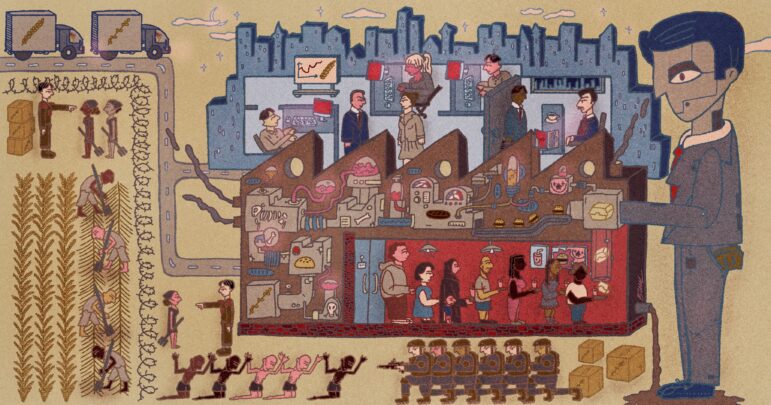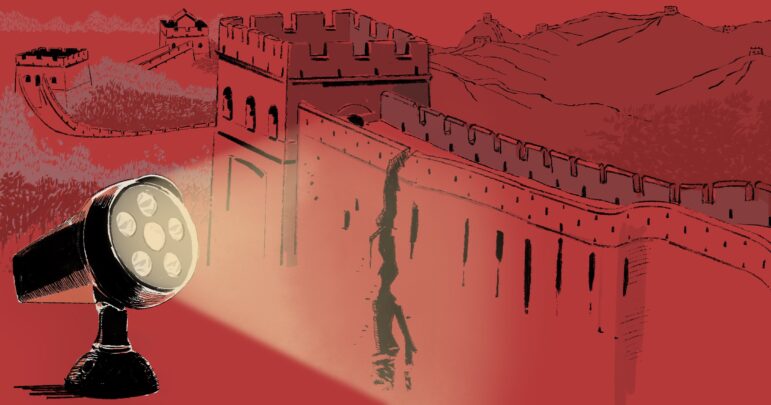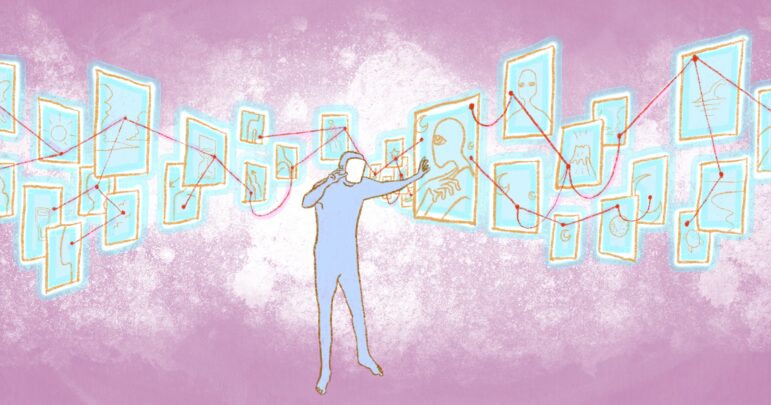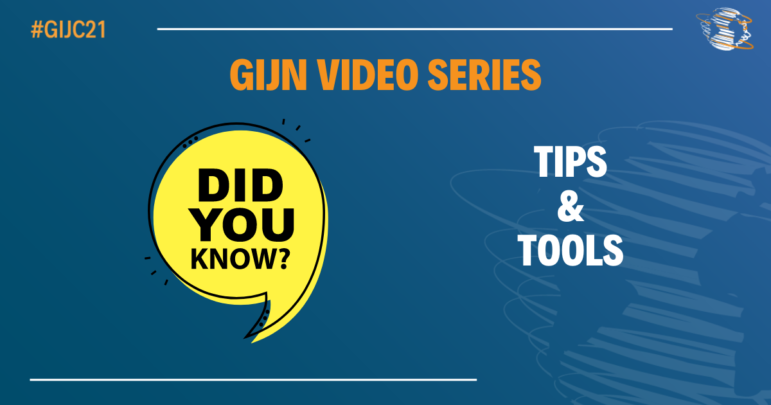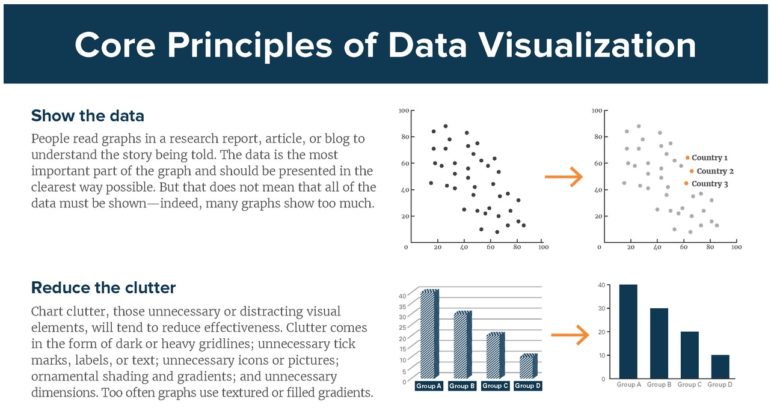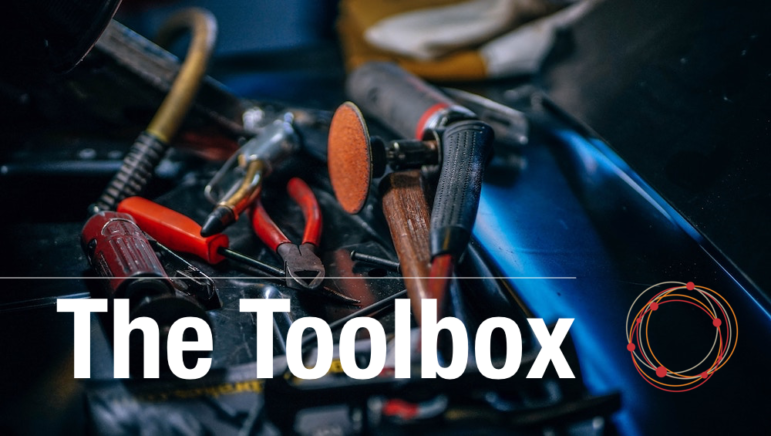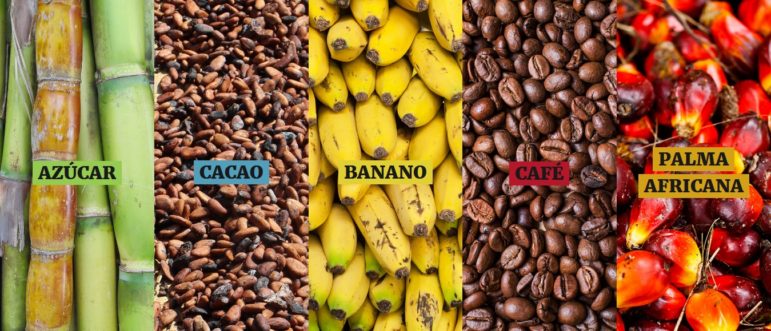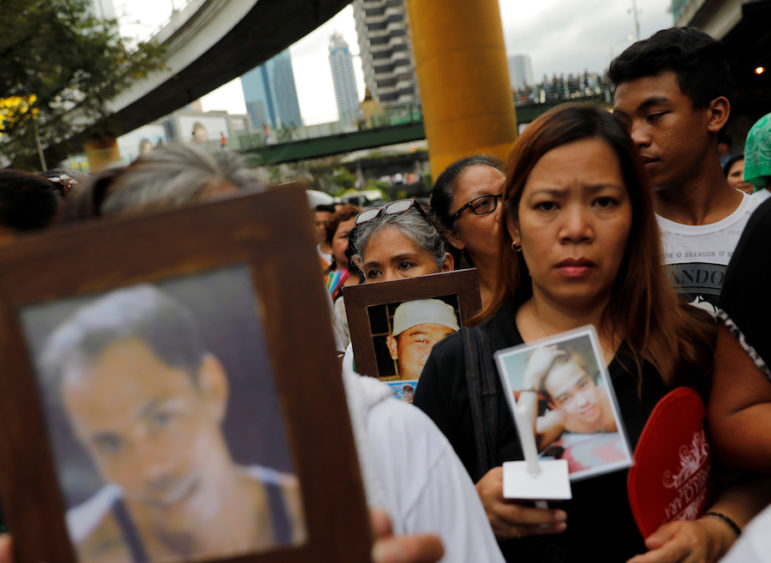

Relatives of victims of extrajudicial killings show portraits of their loved ones during a Catholic mass against drug war killings in Pasig, metro Manila, Philippines on November 5, 2017. Photo: Reuters / Dondi Tawatao
10 Tips on Investigating Extrajudicial Killings: A Case Study from the Philippines

Relatives of victims of extrajudicial killings show portraits of their loved ones during a Catholic mass against drug war killings in Pasig, metro Manila, Philippines on November 5, 2017. Photo: Reuters / Dondi Tawatao
Editor’s Note: The space for press freedom in the Philippines is shrinking rapidly as levels of intimidation against the media are rising, according to press watchdogs. Rappler is but one of GIJN’s members in that nation now under sustained attack by President Rodrigo Duterte and his cronies. The news site is facing 11 legal cases that are politically motivated; its respected editor Maria Ressa is under indictment; and its staff are getting routine death threats for their gutsy reporting on a government-sponsored “war on drugs” that, according to Human Rights Watch, has killed some 23,000 people since 2016.
With the fate of our colleagues there in mind, GIJN is presenting this guide to investigating extra-judicial killings drawn from the experiences of two extraordinary journalists in the Philippines: Rappler’s Patricia Evangelista and Reuters’ Clare Baldwin. These tips were originally presented at the Asian Investigative Journalism Conference in Seoul last October.
Extrajudicial killing — murder carried out by state actors or by non-state vigilantes with the cover of state sanction — is the ultimate abuse of power and violation of rights. Reporting on such murders poses specific challenges to investigative journalists.
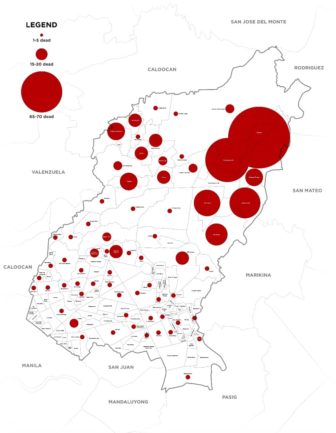
Mapping Murders: Red spots denote deaths that have occurred. The size of the dots increase with the number of deaths. Image: Screenshot from Rappler’s story.
Journalists have to figure out how to sort the truth from rumors, bear witness for powerless people and identify lines of accountability when they have been obscured. Rappler’s investigative reporter Patricia Evangelista from the Philippines and Pulitzer Prize-winning special correspondent for Reuters Clare Baldwin both have experience covering such difficult subject matter — they have fearlessly reported on president Rodrigo Duterte’s war against drugs since he took office in 2016.
Duterte’s hardline stance and public call for citizens to eliminate drug traffickers has resulted in thousands of deaths of alleged drug-dealing suspects, some killed by vigilantes and others murdered by cops themselves (the death tally varies widely according to which agency is counting). His government has also been releasing corrective issuances over the past few years to justify its extreme anti-drug policy. To tackle this monstrous human rights violation, Evangelista and Baldwin shared their tips for digging deep into extrajudicial killings.
1. Collect and Map the Data
When data is not readily available, collect it. To get an estimate of the number of suspected drug-related murders, Baldwin traveled to different police stations in the Philippines and took pictures of handwritten police records as well as collected electronic data from police databases. The information she collected was useful as it had the names of victims, GPS coordinates of the kills and narrative descriptions of what happened.
Piecing together all the information she retrieved was labor intensive, but it allowed her to establish a record of what had happened. “Mapping the killings is important because you can then look for the concentrations,” she said.
2. Data Is More Than Just Numbers
As the drug war progressed, Baldwin’s colleague, a Reuters’ photographer, realized that it was getting increasingly difficult to take pictures of bodies at the crime scenes because they were being whisked away to hospitals very quickly. Baldwin and the photographer were equally perplexed. “We thought: These people were quite dead; why are the bodies going to the hospital [instead of the mortuary]? So we followed the trail in the police records.”
Surprisingly, they discovered that instead of being declared “dead on the spot” as it had occurred, the police records stated that these victims had been “dead on arrival” at the hospital. “Dead on arrival, dead on the spot. We treated those terms as data and established the lexicon of terror, the language Duterte used to kill people,” Baldwin said.
By mapping out these common phrases, she was able to establish that in the beginning, a greater proportion of drug suspects were recorded as shot dead on the spot, while later there were a lot more dead on arrivals. This helped lay the foundation for her story suggesting that the police were sending corpses to hospitals to cover up summary executions.
3. Interrogate the Data
There can be more than one story hidden in the data. Rappler and Reuters both asked the question “Which police station racked up the most drug-related deaths?” and came to the same conclusion. Batasan Police Station 6 in Quezon City turned out to be the most lethal. Baldwin took a closer look at Station 6 and discovered that the officers who formed the core of the anti-drug unit there were either from or near Davao, the hometown of president Duterte.

Lethal Squad: The anti-drug unit at Station 6, who called themselves Davao Boys, killed 108 people in the drug war campaign’s first year. Image: Screenshot from Reuters’ story.
4. Reverse Data Patterns Also Tell a Story
While it is natural to focus on the number of deaths and location of extrajudicial killings, Rappler decided to flip the narrative. Evangelista said they first mapped where people died with big red dots, which turned out to be a lot of slum areas. Using the same map, they also highlighted the places where people did not die — the privileged zones, places where people could afford private education, gated communities and prime real estate. “Where people did not die proved that this is not a war on drugs. It is a class war, a war against the poor and most vulnerable.”
5. Find the Emotive Angle
If the media reports on massacre after massacre, there comes a point where the public might get numb to such stories. Consider other angles with an emotional arc. “Tell the stories of families seeking justice, the extent of what lengths they will go to for their family,” Baldwin suggested. For example, she shadowed and reported on a family’s entire process of finding answers from beginning to end, from the funeral parlor to a second autopsy.
Reuters also used screen grabs from the footage of four surveillance cameras to give the public an idea of how these killings are carried out. “It was the first time people could see what really happens. Showing them what it looks like is important as well.”
6. Get Expert Analysis on Crime Scene Photos
Medical investigators or forensic scientists can tell you a lot about what happened from crime scene photos. Compare their expert analysis to official police records to see if things check out. Baldwin cited an example of a police drug raid that caused the death of several men. Police accounts stated that the victims were shot while fleeing a gun battle. The crime scene photos, however, suggested a different narrative.
“The victims suffered shots through their hands,” Baldwin said. “Those are typically defensive wounds. They were probably not firing a gun but trying to defend themselves.” Other clues that didn’t add up included the bloodstain patterns and the clustering of gunshot wounds.
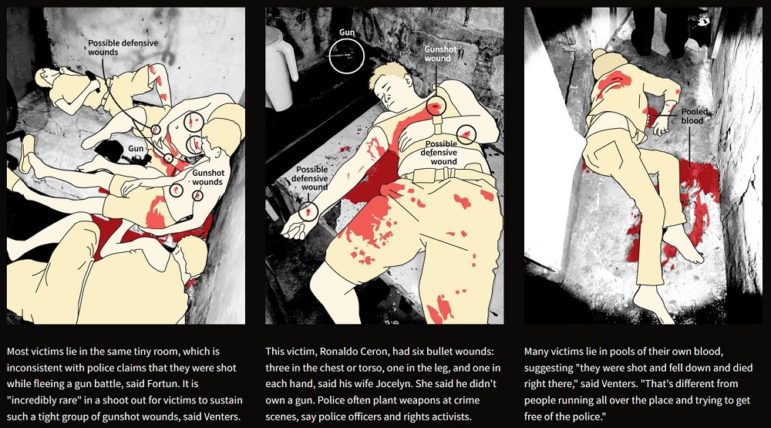
Forensic Analysis: Gunshot wounds and bloodstain patterns of several drug suspects did not match the police’s account of the incident. Image: Screenshot of Reuters’ story.
7. Accuracy Is Key
The stakes are high for covering extrajudicial killings. By their nature, they are difficult to prove, especially when authorities are complicit. Police reports may be questionable. “So layer witness testimony upon testimony, get paranoid as hell and bulletproof your story,” Evangelista stressed.
8. Know When to Walk Away
“You are the person uninvited at the crime scene. You are present at the worst moment of a person’s life. How you approach that person will matter to them, and it will also matter in the long term because that is how they will decide whether to talk to you in the future,” Evangelista said. She advised journalists to be patient in waiting for the next of kin to grant permission for an interview.
“If they tell you that they are afraid and that talking to you might put their lives in danger, do not force them,” Evangelista added. “Say ‘I’m so sorry, my condolences’ and walk away.” If they consent to an interview, avoid asking questions like “How do you feel?,” “Is your son guilty?” or “Do you feel guilty for not being able to look out for your child?” Instead, Evangelista suggested, start by asking them what they had for breakfast, their name, jobs, their son’s age, or how many children they have, because facts are the easiest things to answer.
9. Protect Your Witnesses
Protecting witnesses doesn’t just mean changing witnesses’ names or blurring their faces in the final publication, Evangelista emphasized. She said it is important to explain to them that once the story goes public, people may eventually figure out who they are. “The moment people know who the victim is, it is possible to find out who the wife is or who the children are.”
Make sure they are aware of that and have a way to call you or somewhere to run in case something happens. Connect them to people (and organizations) that can protect them.
10. Keep Yourself Safe and Your Communications Secure
Both Evangelista and Baldwin agreed that journalists should not cover extrajudicial killings alone. “Make sure you have someone with you, a photographer, a fixer or someone else,” Evangelista stressed. Baldwin added that it is imperative to keep a point of contact informed at all times about your whereabouts and who you are meeting. Varying your daily routine is also a good security measure. “Stay in different hotels, go out at different times of day. The more irregular your schedule, the better,” Baldwin said.
As a standard practice, journalists should also be encrypting everything from emails to text. “It is also important not to tell your sources which other sources you are talking to, particularly when these sources might kill other sources,” Evangelista said.
At the end of the session, both journalists talked about how they manage to stay focused and not go off the rails while covering such traumatic events. Baldwin said that having regular conversations with her colleagues helped keep her sane. “We talk about logistics, hotels. Just having someone to bounce ideas off and talk to is important.”
Evangelista agreed that having a “tribe” to talk to is important. She also swears by this personal practice: “I only read books and watch movies with happy endings.”
For more investigations into Duterte’s drug war, read Rappler’s Impunity Series and seven-part Murder in Manila series, and Reuters’ Pulitzer Prize-winning series Duterte’s War.
 Eunice Au is GIJN’s program coordinator. Previously, she was a Malaysia correspondent for Singapore’s The Straits Times, and a journalist at the New Straits Times. She has also written for The Sun, Malaysian Today and Madam Chair.
Eunice Au is GIJN’s program coordinator. Previously, she was a Malaysia correspondent for Singapore’s The Straits Times, and a journalist at the New Straits Times. She has also written for The Sun, Malaysian Today and Madam Chair.


